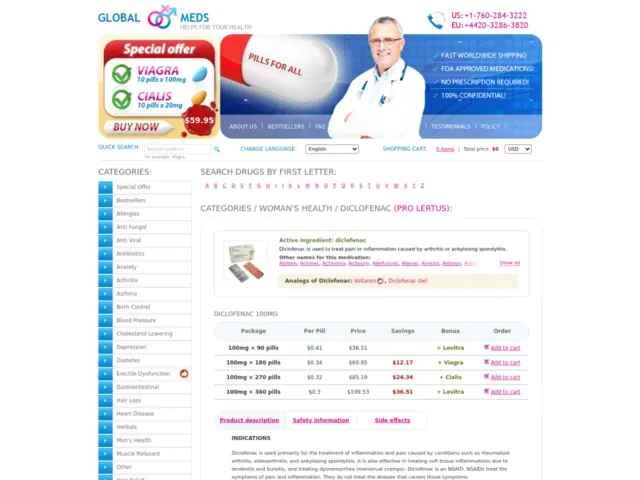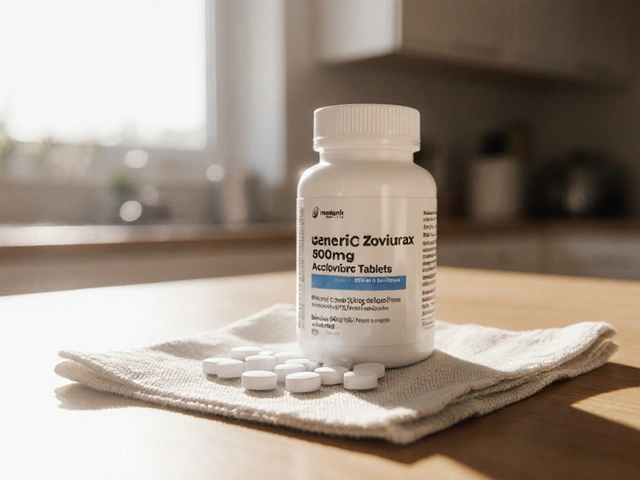Key Takeaways
- Cefixime is a third‑generation oral cephalosporin best for certain gram‑negative infections.
- Amoxicillin offers a broader gram‑positive range and is cheaper but hits fewer resistant bugs.
- Azithromycin’s long half‑life makes it convenient for STI and respiratory infections.
- Fluoroquinolones (ciprofloxacin, levofloxacin) are powerful against Pseudomonas but carry higher safety warnings.
- Doxycycline and trimethoprim‑sulfamethoxazole fill niche roles where resistance patterns favor them.
When you or a loved one is prescribed an antibiotic, the label often reads “Cefixime.” But you might be wondering if there’s a better fit for the infection you’re fighting. This guide lines up Cefixime against the most commonly used alternatives, breaking down spectrum, dosing, safety, and cost so you can see which drug matches your needs.
What is Cefixime?
Cefixime is a third‑generation oral cephalosporin antibiotic that works by inhibiting bacterial cell‑wall synthesis, making it effective against many gram‑negative organisms while retaining some gram‑positive activity. It was first approved in the United States in 1999 and is marketed under brand names such as Suprax and Zifi. Typical adult dosing is 400mg once daily for uncomplicated urinary tract infections (UTIs) or 400mg twice daily for more serious infections like gonorrhea. Its bioavailability exceeds 90%, so food does not dramatically affect absorption.
Common Alternatives to Cefixime
Below are the six antibiotics that clinicians most often consider when Cefixime isn’t ideal. Each belongs to a different class, which means the way they attack bacteria-and their side‑effect profiles-vary widely.
- Amoxicillin - a penicillin‑type drug with strong gram‑positive coverage.
- Azithromycin - a macrolide prized for its long half‑life and tissue penetration.
- Ciprofloxacin - a fluoroquinolone with excellent activity against Pseudomonas and many gram‑negative bugs.
- Doxycycline - a tetracycline that’s useful for atypical organisms and intracellular pathogens.
- Trimethoprim‑sulfamethoxazole (TMP‑SMX) - a sulfonamide combination effective for UTIs and some skin infections.
- Levofloxacin - another fluoroquinolone with a broader gram‑positive reach than ciprofloxacin.

Quick Comparison Table
| Drug | Class | Typical Adult Dose | Gram‑Positive Spectrum | Gram‑Negative Spectrum | Notable Safety Concerns | Cost (US, generic) |
|---|---|---|---|---|---|---|
| Cefixime | Cephalosporin (3rd gen) | 400mg PO daily | Moderate (Streptococcus spp.) | Strong (E. coli, Klebsiella, N. gonorrhoeae) | Diarrhea, rare allergic cross‑reactivity | $$ |
| Amoxicillin | Penicillin | 500mg PO TID | Strong (Streptococcus, Enterococcus) | Limited (H. influenzae) | Allergy, GI upset | $ |
| Azithromycin | Macrolide | 500mg PO daily ×3days | Good (Strep, Staph) | Good (Chlamydia, Mycoplasma) | QT prolongation, hepatotoxicity | $$ |
| Ciprofloxacin | Fluoroquinolone | 500mg PO BID | Moderate (Pseudomonas, some Staph) | Excellent (Enterobacteriaceae, Pseudomonas) | Tendon rupture, CNS effects | $$ |
| Doxycycline | Tetracycline | 100mg PO BID | Moderate (Rickettsia, Borrelia) | Moderate (some gram‑negatives) | Photosensitivity, esophageal irritation | $ |
| Trimethoprim‑sulfamethoxazole | Sulfonamide combo | 800/160mg PO BID | Good (Staph, Strep) | Good (E. coli, Proteus) | Kidney issues, hypersensitivity | $ |
| Levofloxacin | Fluoroquinolone | 750mg PO daily | Strong (Strep, Staph) | Strong (Enterobacteriaceae) | Tendon risk, QT prolongation | $$ |
Deep‑Dive Into Each Alternative
Amoxicillin
Amoxicillin shines in infections where gram‑positive bacteria dominate-think strep throat, otitis media, and uncomplicated sinusitis. Because it’s cheap and widely available, it’s the first line for many community‑acquired infections. However, its gram‑negative punch is thin, so it’s not the go‑to for urinary tract infections caused by resistant E.coli.
Azithromycin
Azithromycin’s advantage is dosing convenience: a three‑day pack often clears the infection, which boosts adherence. It’s the preferred oral drug for chlamydia, gonorrhea (in combination therapy), and atypical pneumonia. The downside? Rising macrolide resistance in S.pneumoniae and notable cardiac concerns for patients on other QT‑prolonging meds.
Ciprofloxacin
Ciprofloxacin covers the hard‑to‑kill Gram‑negatives, including Pseudomonas aeruginosa, making it a staple for complicated UTIs, intra‑abdominal infections, and certain travel‑related diarrheas. Regulatory agencies have added boxed warnings about tendon rupture and peripheral neuropathy, nudging clinicians to reserve it for cases where other drugs fail.
Doxycycline
Doxycycline is a workhorse for tick‑borne diseases (Lyme, RockyMountain spotted fever), acne, and as a second‑line for community‑acquired pneumonia when atypicals are suspected. Its anti‑inflammatory properties add a bonus for acne. However, it can cause photosensitivity-sun‑loving patients should watch out.
Trimethoprim‑sulfamethoxazole (TMP‑SMX)
TMP‑SMX hits a sweet spot for many uncomplicated UTIs, especially when resistance to trimethoprim alone is high. It also treats certain skin infections (e.g., impetigo) and Pneumocystis jirovecii prophylaxis. Renal patients need dose adjustments, and the sulfa component can trigger rash in sensitive individuals.
Levofloxacin
Levofloxacin offers a broader gram‑positive reach than ciprofloxacin while preserving fluoroquinolone potency against gram‑negatives. It’s often used for community‑acquired pneumonia and sinusitis. Like its cousin, it carries tendon‑related warnings and should be avoided in pregnant women.
How to Choose the Right Antibiotic
Picking the best drug isn’t just about which one looks cheaper. Consider these decision criteria:
- Infection site and likely bacteria. Respiratory infections often need macrolides or doxycycline; urinary infections respond well to cefixime, TMP‑SMX, or fluoroquinolones.
- Local resistance patterns. If your area reports high macrolide resistance in S.pneumoniae, azithromycin may be less reliable.
- Patient allergies. Penicillin‑allergic patients can’t take amoxicillin; sulfa‑allergic patients should avoid TMP‑SMX.
- Safety profile. Elderly patients with tendon issues should avoid fluoroquinolones; pregnant women need to steer clear of doxycycline and fluoroquinolones.
- Convenience and adherence. A once‑daily regimen (e.g., cefixime or levofloxacin) often beats multiple‑dose schedules.
- Cost and insurance coverage. Generic amoxicillin and doxycycline are typically the cheapest.
By matching these factors against the table above, you can see where Cefixime fits. It’s a solid middle‑ground: good gram‑negative coverage, once‑daily dosing, and moderate cost, but it isn’t the best for gram‑positive‑dominant infections or for patients with a cephalosporin allergy.
Pros and Cons Summary
| Aspect | Cefixime | Alternatives |
|---|---|---|
| Spectrum | Strong gram‑negative, moderate gram‑positive | Varies: amoxicillin (gram‑positive), fluoroquinolones (broad) |
| Dosage convenience | Once daily | Azithromycin (once daily 3‑day), levofloxacin (once daily), others multiple daily doses |
| Safety warnings | Allergy cross‑reactivity | Fluoroquinolones (tendon), macrolides (QT), doxycycline (photosensitivity) |
| Cost | $$ | Amoxicillin/Doxycycline $; fluoroquinolones $$ |
Next Steps for Patients
If you’ve been prescribed cefixime and wonder whether another drug would be better, follow these steps:
- Ask your provider about the likely bacteria causing your infection.
- Check if you have any drug allergies (penicillin, sulfa, cephalosporin).
- Discuss any existing conditions-diabetes, kidney disease, heart rhythm issues-that could affect safety.
- Consider the dosing schedule; a simpler regimen boosts adherence.
- If cost is a concern, request a generic alternative that matches the spectrum you need.
Armed with this information, you can have an informed conversation and ensure you get the most effective, safest, and affordable antibiotic for your situation.
Frequently Asked Questions
Can I switch from cefixime to amoxicillin if I develop a rash?
Yes, but only after confirming the rash isn’t a severe allergic reaction. Amoxicillin belongs to a different class (penicillin) and usually doesn’t cross‑react with cephalosporins, though rare exceptions exist. Talk to your clinician before changing.
Is cefixime effective for gonorrhea?
Cefixime was once a first‑line oral option for uncomplicated gonorrhea, but rising resistance rates have led many health agencies to recommend dual therapy (ceftriaxone injection plus azithromycin) instead.
What should I do if I miss a cefixime dose?
Take the missed dose as soon as you remember, unless it’s almost time for the next dose. In that case, skip the missed one-don’t double up.
Are fluoroquinolones safer than cefixime?
Safety depends on the individual. Fluoroquinolones have black‑box warnings for tendon rupture and CNS effects, while cefixime’s main risk is allergic reaction. For most healthy adults, cefixime is considered safer.
Which antibiotic is best for a simple urinary tract infection?
Cefixime, TMP‑SMX, and nitrofurantoin are commonly used. Choice hinges on local resistance data and patient tolerance. Many clinicians start with TMP‑SMX for cost, moving to cefixime if resistance is high.





Tyler Heafner - 12 October 2025
When evaluating antibiotic options, it is essential to consider both the microbial spectrum and patient-specific factors. Cefixime offers robust gram‑negative coverage while maintaining a convenient once‑daily dosing schedule. For individuals with a history of penicillin allergy, it can serve as a viable alternative provided no cephalosporin cross‑reactivity exists. Cost considerations are also pertinent; although not the cheapest option, its efficacy may justify the expense in resistant infections. Always discuss with your healthcare provider to align the choice with local resistance patterns and your personal health profile.
Gene Nilsson - 23 October 2025
It is morally indefensible to prescribe broad‑spectrum agents like cefixime without first exhausting narrow‑spectrum alternatives. Overuse fuels resistance, jeopardizing future patients' treatment options. One must exercise prudence and stewardship, lest we betray our duty to safeguard public health.
Maryanne robinson - 2 November 2025
Alright, let’s break this down step by step so you can feel confident about your antibiotic choices. First, understand that cefixime shines when you need solid gram‑negative power, especially for urinary tract infections and certain sexually transmitted infections, but it isn’t the champion of gram‑positive coverage. If your infection is likely caused by strep or other gram‑positive bugs, amoxicillin or even doxycycline might hit the target more directly and often at a lower cost.
Next, think about dosing convenience. Cefixime’s once‑daily regimen can improve adherence compared to drugs that require multiple daily doses, such as ciprofloxacin which often demands twice‑daily dosing. However, azithromycin also offers a short course that many patients find easy to follow.
Safety is another critical piece. Fluoroquinolones carry black‑box warnings for tendon rupture and CNS effects, making them a less attractive first‑line choice for many, especially the elderly. Cefixime’s main safety concern is allergic cross‑reactivity, which is relatively rare but still important to screen for.
Cost matters as well. Generic amoxicillin and doxycycline are typically the cheapest options, while cefixime and the fluoroquinolones sit in a moderate price range. If insurance coverage is an issue, discussing alternatives with your provider can uncover a more affordable yet effective regimen.
Finally, consider local resistance patterns. In areas with high macrolide resistance, azithromycin may lose its edge, whereas in regions with rising cephalosporin resistance, you might need to pivot to a different class. The key is a collaborative conversation with your clinician, using this information to tailor therapy to your specific infection and personal health factors.
Vintage Ireland - 13 November 2025
Hey, totally get how overwhelming it can feel sorting through all these meds. The good news is you don’t have to be a pharmacy wizard – just think about where the infection lives and what bugs are common there. Talk to your doc about any allergies and they’ll help match the right drug, whether it’s cefixime for a stubborn UTI or something like doxycycline for a tick bite.
Anshul Gupta - 23 November 2025
Wow, another glorified drug list. As if we needed more marketing fluff about "once‑daily convenience". Cefixime? Sure, if you love paying extra for a pill that does the same thing as cheaper TMP‑SMX. And those fluoroquinolones? Just a ticking time‑bomb for tendons. Everyone pretends they’re choosing wisely while the pharma‑driven hype does the heavy lifting.
Danny de Zayas - 3 December 2025
Valid points.